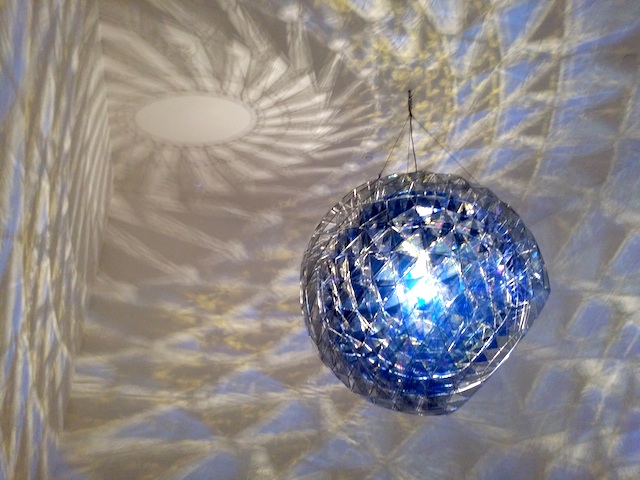 |
| Olafur Eliasson, Cold Wind Sphere, 2012 |
When the Centre Pompidou changes the
display of the permanent collection, it's an occasion. And the
new curation of the permanent collection is just that: a treat to be savored. The
hanging follows on, chronologically and within the space of the museum, from
the issues and concerns of the Magiciens
de la Terre redux. Even though it isn’t made obvious enough, the collection
presents post-1980s art that follows the themes begun by the original Magiciens de la Terre in 1989.
 |
| Walid Raad, Hostage: The Bachar Tapes Souheil Bachar, 2001 |
In some of the early rooms of the new
hanging, visitors are introduced to single works by artists from the world’s
most troubled post-1989 regions. Works from the Middle East, Serbia, Albania,
and of course, Israel and Palestine are captivating for what they show as much
as what they do not show. To my own
surprise I really enjoyed Walid Raad’s video, Hostage: The Bachar Tapes Souheil Bachar, 2001. I was surprised because I
have never seen what the fuss around Raad’s work was all about. Hostage tells the story of the low-level
Lebanese worker from the Kuwaiti embassy in Beirut who was held with the
American hostages caught in the crossfire over the Iran-contra affair during the second
Reagan administration. Raad re-presents Souheil Bachar’s video tapes #1, #17
and #31 in which he tells the shocking narrative of the Americans who wanted
him to fuck them. In a female voiceover that overlays animated images of the hostages,
Bachar remembers the American’s obsession with their own bodily hygiene and
their disgust at his. And yet, they could not stop touching him. One night he
even felt one of the American’s press his body so close that he felt his
erection. The narrative is shocking, not because we hear anything we didn’t
already know, but because Bachar’s story, as it is represented by Raad, reduces
this public political event to a private struggle of the Americans with their
own bodies.
 |
| Maja Bajevic, Women at Work (Under Construction) In Construction, 1999 |
The works in these early rooms that reuse the
archival were exceptionally compelling: Maja Bajevic’s Women at Work (Under Construction) In Construction, 1999 was
wonderful. Bajevic stages women war refugees embroidering the scrim that
protects scaffolding while the National Gallery in Sarajevo was being
renovated. On the one hand, it’s a very familiar use of women’s work to
re-articulate a public and political space, and on the other hand, as a form of
memorial to the war in Bosnia-Herzegovnia, it’s an innovative and powerful challenge
to social change. Chris Marker’s Detour
Ceausescu, 1990 in which he uses the footage from the Romanian revolution
that we know from Farocki and Ujica’s Videogramme
of a Revolution, or Thomas Hirschhorn’s Outgrowth,
2005, are very powerful critiques of state violence. Hirschhorn’s familiar
anti-aesthetic is both amusing and
disturbing in Outgrowth: globes on
shelves have growths covered in masking tapes, as though they have contracted
some kind of virulent disease. Taped to the shelves on which they sit are these
magazine pictures of disasters, state violence and war. The message is clear.
 |
Thomas Hirschhorn, Outgrowth, 2005
|
Other political works of art, especially
those that engage with the world and make us look at it in different ways were also
extremely powerful. I sat through Tony Oursler’s New York 9/11 as he captures the events unfolding and the responses
of New Yorkers in the days that followed. As his camera moves in and around
ground zero and the streets of New York City, I was deeply moved by a city
coming to terms with this great disaster. Even though the hand held camera and
other aspects of the aesthetic might be otherwise alienating, I was transported
back into the confusion of those days following September 11, 2001. An
interesting contribution from Amar Kanwar on the ecological fallout as a result
of industrial developments in India: The Scene of the Crime, 2011 was also moving, though it unfolded in a slower, more subtle
and almost invisible way, just like the disaster it documents.
 |
| Amar Kanwar, The Scene of the Crime, 2005 |
Works that were not as directly political
are also in abundance, even though I did not spend as much time with them.
There were rooms filled with experimental art, post-minimalist works by Daniel
Buren, Steven Parrino’s Necropolis (the
Lucifer Crank) for Anger, 2004 – a post-avant garde, post-structuralist
film. An absolutely divine piece by Olafur Eliasson, Cold Wind Sphere, 2012, in which light creates space, memory and a
world of its own. There were also works from the collection with which I was not
previously familiar, and was inspired to see more: Alain Bublex’s Plug-In City, 2000, being one example.





No comments:
Post a Comment